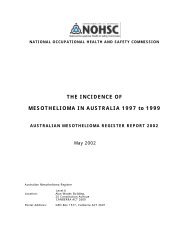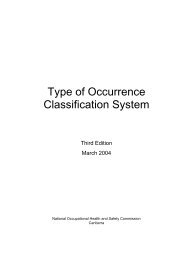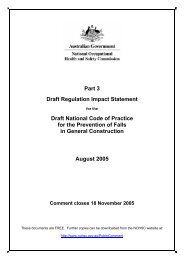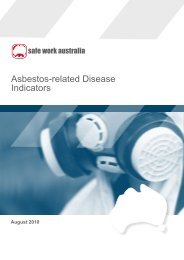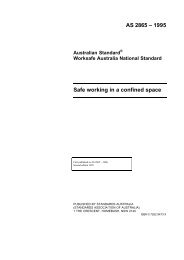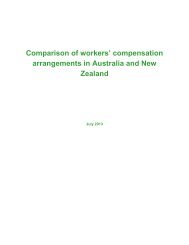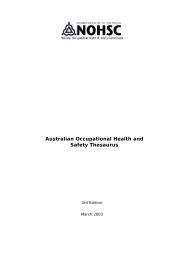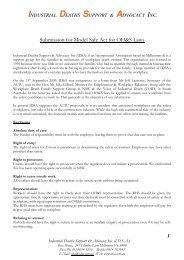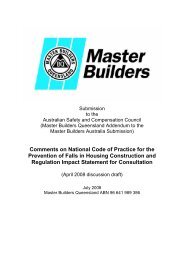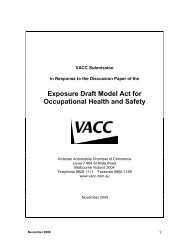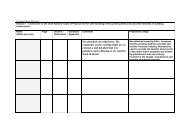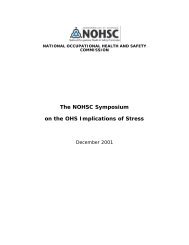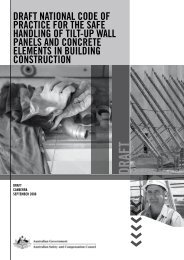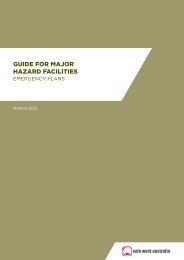how to determine what is reasonably practicable to meet a health ...
how to determine what is reasonably practicable to meet a health ...
how to determine what is reasonably practicable to meet a health ...
You also want an ePaper? Increase the reach of your titles
YUMPU automatically turns print PDFs into web optimized ePapers that Google loves.
HOW TO DETERMINE WHAT ISREASONABLY PRACTICABLE TOMEET A HEALTH AND SAFETY DUTYMAY 2013
Safe Work Australia <strong>is</strong> an Australian Government statu<strong>to</strong>ry agency establ<strong>is</strong>hed in 2009. Safe WorkAustralia cons<strong>is</strong>ts of representatives of the Commonwealth, state and terri<strong>to</strong>ry governments, theAustralian Council of Trade Unions, the Australian Chamber of Commerce and Industry and theAustralian Industry Group.Safe Work Australia works with the Commonwealth, state and terri<strong>to</strong>ry governments <strong>to</strong> improvework <strong>health</strong> and safety and workers’ compensation arrangements. Safe Work Australia <strong>is</strong> a nationalpolicy body, not a regula<strong>to</strong>r of work <strong>health</strong> and safety. The Commonwealth, states and terri<strong>to</strong>rieshave responsibility for regulating and enforcing work <strong>health</strong> and safety laws in their jur<strong>is</strong>diction.ISBN 978-1-74361-065-7 [PDF]ISBN 978-1-74361-066-4 [RTF]Creative CommonsExcept for the logos of Safe Work Australia, SafeWork SA, WorkCover Tas, WorkSafe WA,Workplace Health and Safety QLD, NT WorkSafe, Work Cover NSW, Comcare and WorkSafeACT, th<strong>is</strong> copyright work <strong>is</strong> licensed under a Creative Commons Attribution-Noncommercial 3.0Australia licence. To view a copy of th<strong>is</strong> licence, v<strong>is</strong>ithttp://creativecommons.org/licenses/by-nc/3.0/au/In essence, you are free <strong>to</strong> copy, communicate and adapt the work for non commercial purposes,as long as you attribute the work <strong>to</strong> Safe Work Australia and abide by the other licence terms.Contact informationSafe Work AustraliaPhone: 1300 551 832Email: info@swa.gov.auWebsite: www.swa.gov.au
TABLE OF CONTENTS1 INTRODUCTION 21.1 What <strong>is</strong> the purpose of th<strong>is</strong> Guide? 21.2 The duties of a person conducting a businessor undertaking 26 STEP FOUR - REVIEWING RISK CONTROLS 186.1 When should r<strong>is</strong>k controls be reviewed? 18Appendix - L<strong>is</strong>t of cases relevant indetermining reasonable practicability 192 THE MEANING OF REASONABLYPRACTICABLE 42.1 How <strong>is</strong> ‘<strong>reasonably</strong> <strong>practicable</strong>’ defined? 42.2 What each of the ‘relevant matters’ insection 18 mean 52.3 A r<strong>is</strong>k management process helps <strong>to</strong><strong>determine</strong> <strong>what</strong> <strong>is</strong> <strong>reasonably</strong> <strong>practicable</strong> 62.4 What <strong>is</strong> ‘<strong>reasonably</strong> <strong>practicable</strong>’ <strong>is</strong> anobjective test 72.5 The relevance of control 73 STEP ONE: IDENTIFYING THECIRCUMSTANCES, HAZARDS AND RISKS 93.1 What are the circumstances? 93.2 What are the hazards ar<strong>is</strong>ing from the workor the environment? 93.3 What are the r<strong>is</strong>ks associated with thosehazards and <strong>how</strong> serious are they? 103.4 The importance of consultation 114 STEP TWO – DETERMINE WHAT YOUCAN DO 124.1 Deciding <strong>how</strong> r<strong>is</strong>ks can be eliminated orminim<strong>is</strong>ed (r<strong>is</strong>k controls) 124.2 Is the control measure available and suitable? 135 STEP THREE – DETERMINE WHAT YOUARE REASONABLY ABLE TO DO 145.1 Start by considering the highest levelof protection 145.2 How <strong>to</strong> <strong>determine</strong> <strong>what</strong> <strong>is</strong> reasonable 145.3 Cost 155.4 Can you rely on someone else <strong>to</strong> take thenecessary action? 16HOW TO DETERMINE WHAT IS REASONABLY PRACTICABLE TO MEET A HEALTH AND SAFETY DUTY | MAY 20131
1. INTRODUCTION1.1 What <strong>is</strong> the purpose of th<strong>is</strong> Guide?Th<strong>is</strong> document provides guidance on the standard of <strong>health</strong> and safety that a personconducting a business or undertaking (PCBU) must <strong>meet</strong> under the Work Health and Safety(WHS) Act and Regulations. A PCBU must do <strong>what</strong> <strong>is</strong> ‘<strong>reasonably</strong> <strong>practicable</strong>’ <strong>to</strong> ensure<strong>health</strong> and safety.The standard of ‘<strong>reasonably</strong> <strong>practicable</strong>’ in <strong>health</strong> and safety duties only applies <strong>to</strong> a PCBU.Other duty holders are required <strong>to</strong> <strong>meet</strong> different standards, for example officers mustexerc<strong>is</strong>e ‘due diligence’ and workers and others at a workplace must take ‘reasonable care’.The ‘<strong>reasonably</strong> <strong>practicable</strong>’ standard <strong>is</strong> not a new one in Australian work <strong>health</strong> and safetylaw. The standard <strong>is</strong> intended <strong>to</strong> be a very high one. Th<strong>is</strong> <strong>is</strong> reflected in one of the objectsat section 3(2) of the WHS Act stating that workers and other persons should be given thehighest level of protection from hazards and r<strong>is</strong>ks ar<strong>is</strong>ing from work, so far as <strong>is</strong> <strong>reasonably</strong><strong>practicable</strong>.Section 18 of the WHS Act sets out the definition of <strong>reasonably</strong> <strong>practicable</strong> in relation <strong>to</strong> aduty <strong>to</strong> ensure <strong>health</strong> and safety and the matters <strong>to</strong> be taken in<strong>to</strong> account in determining<strong>what</strong> <strong>is</strong> <strong>reasonably</strong> <strong>practicable</strong> in the circumstances.Th<strong>is</strong> Guide explains each of the elements of th<strong>is</strong> definition and provides practical guidance on<strong>how</strong> <strong>to</strong> <strong>determine</strong> <strong>what</strong> <strong>is</strong> <strong>reasonably</strong> <strong>practicable</strong>.1.2 The duties of a person conducting a business orundertakingSection 17Management of r<strong>is</strong>ksA duty imposed on a person <strong>to</strong> ensure <strong>health</strong> and safety requires the person <strong>to</strong> eliminater<strong>is</strong>ks <strong>to</strong> <strong>health</strong> and safety so far as <strong>is</strong> <strong>reasonably</strong> <strong>practicable</strong>, and if it <strong>is</strong> not <strong>reasonably</strong><strong>practicable</strong> <strong>to</strong> do so, <strong>to</strong> minim<strong>is</strong>e the r<strong>is</strong>ks so far as <strong>is</strong> <strong>reasonably</strong> <strong>practicable</strong>.Sections 19 <strong>to</strong> 26 of the WHS Act require a PCBU <strong>to</strong> ensure, so far as <strong>is</strong> <strong>reasonably</strong><strong>practicable</strong>:• the <strong>health</strong> and safety of workers who are engaged or caused <strong>to</strong> be engaged by thePCBU, or whose work <strong>is</strong> directed or influenced by the PCBU• the <strong>health</strong> and safety of people who are not workers, such as members of the public,<strong>is</strong> not put at r<strong>is</strong>k from work carried out as part of the conduct of the business orundertaking• their own <strong>health</strong> and safety, if the PCBU <strong>is</strong> a self-employed person• a workplace of which the PCBU has management or control <strong>is</strong> without r<strong>is</strong>ks <strong>to</strong> the <strong>health</strong>and safety of any person, including the means of entering and exiting the workplace• the fixtures, fittings or plant at a workplace of which the PCBU has management orcontrol are without r<strong>is</strong>ks <strong>to</strong> the <strong>health</strong> and safety of any person2HOW TO DETERMINE WHAT IS REASONABLY PRACTICABLE TO MEET A HEALTH AND SAFETY DUTY | MAY 2013
1. INTRODUCTION• any item of plant, a substance or a structure the PCBU designs, manufactures, imports orsupplies <strong>is</strong> without r<strong>is</strong>ks <strong>to</strong> the <strong>health</strong> and safety of any person described in the sections• the way in which an item of plant or a structure <strong>is</strong> installed, constructed or comm<strong>is</strong>sionedby the PCBU ensures it <strong>is</strong> without r<strong>is</strong>ks <strong>to</strong> the <strong>health</strong> and safety of any person describedin the section.The WHS Regulations also contain requirements for <strong>meet</strong>ing the standard of <strong>reasonably</strong><strong>practicable</strong>:• when managing <strong>health</strong> and safety r<strong>is</strong>ks generally under the regulations (regulation 35)• in relation <strong>to</strong> particular types of hazards and r<strong>is</strong>ks, for example:• ensuring specified aspects of the workplace environment are without r<strong>is</strong>ks <strong>to</strong> <strong>health</strong>and safety (regulation 40)• ensuring the prov<strong>is</strong>ion and maintenance of welfare facilities, such as washing facilitiesand drinking water (regulation 41)• minim<strong>is</strong>ing the r<strong>is</strong>k of falling objects (regulation 55)• minim<strong>is</strong>ing the need for hazardous manual tasks <strong>to</strong> be carried out, when designing anitem of plant or a structure (regulation 61)• eliminating or minim<strong>is</strong>ing the need for entry in<strong>to</strong> a confined space, when designing,manufacturing, importing, supplying, installing or constructing an item of plant or astructure (regulation 64)• ensuring a person does not enter a confined space before specific requirements ofthe regulations have been complied with (regulation 65)• ensuring no person, plant or thing at a workplace comes within an unsafe d<strong>is</strong>tance ofan overhead or underground electric line (regulation 166).HOW TO DETERMINE WHAT IS REASONABLY PRACTICABLE TO MEET A HEALTH AND SAFETY DUTY | MAY 20133
2. THE MEANING OF REASONABLY PRACTICABLE2.2 What each of the ‘relevant matters’ insection 18 meanFac<strong>to</strong>rThe likelihood ofthe hazard or ther<strong>is</strong>k concernedoccurringRelevanceThe greater the likelihood of a r<strong>is</strong>k occurring, the greater thesignificance th<strong>is</strong> will play when weighing up all matters anddetermining <strong>what</strong> <strong>is</strong> <strong>reasonably</strong> <strong>practicable</strong>. If harm <strong>is</strong> more likely<strong>to</strong> occur, then it may be reasonable <strong>to</strong> expect more <strong>to</strong> be done<strong>to</strong> eliminate or minim<strong>is</strong>e the r<strong>is</strong>k.The frequency of an activity or specific circumstances will berelevant <strong>to</strong> the likelihood of a r<strong>is</strong>k occurring. The more a worker<strong>is</strong> exposed <strong>to</strong> a hazard, the more likely they are <strong>to</strong> suffer harmfrom it.The degree of harmthat might resultfrom the hazard orthe r<strong>is</strong>kWhat the personconcernedknows, or ought<strong>reasonably</strong> <strong>to</strong> know,about the hazardor r<strong>is</strong>k, and waysof eliminating orminim<strong>is</strong>ing the r<strong>is</strong>kThe availability andsuitability of ways<strong>to</strong> eliminate orminim<strong>is</strong>e the r<strong>is</strong>kThe greater the degree of harm that could result from the hazardor r<strong>is</strong>k, the more significant th<strong>is</strong> fac<strong>to</strong>r will be when weighingup all matters <strong>to</strong> be taken in<strong>to</strong> account and identifying <strong>what</strong> <strong>is</strong><strong>reasonably</strong> <strong>practicable</strong> in the circumstances. Clearly, more wouldbe expected of a duty-holder <strong>to</strong> eliminate or minim<strong>is</strong>e the r<strong>is</strong>k ofdeath or serious injury than a lesser harm.The knowledge about a hazard or r<strong>is</strong>k, and any ways ofeliminating or minim<strong>is</strong>ing the hazard or r<strong>is</strong>k, will be <strong>what</strong> theduty-holder actually knows, and <strong>what</strong> a reasonable person in theduty-holder’s position (e.g. a person in the same industry) would<strong>reasonably</strong> be expected <strong>to</strong> know. Th<strong>is</strong> <strong>is</strong> commonly referred <strong>to</strong>as the state of knowledge.The courts have cons<strong>is</strong>tently stated a duty holder must considerall <strong>reasonably</strong> foreseeable hazards and r<strong>is</strong>ks when identifying<strong>what</strong> <strong>is</strong> <strong>reasonably</strong> <strong>practicable</strong>.Th<strong>is</strong> requires consideration of not only <strong>what</strong> <strong>is</strong> available, butalso <strong>what</strong> <strong>is</strong> suitable for the elimination or minim<strong>is</strong>ation of r<strong>is</strong>k.A r<strong>is</strong>k control that may be effective in some circumstances orenvironments may not be effective or suitable in others, becauseof things such as the workplace layout, skills of relevant workers,or the particular way in which the work <strong>is</strong> done.Equipment <strong>to</strong> eliminate or minim<strong>is</strong>e a hazard or r<strong>is</strong>k <strong>is</strong> regardedas being available if it <strong>is</strong> provided on the open market, or if it <strong>is</strong>possible <strong>to</strong> manufacture it.A work process (or change <strong>to</strong> a work process) <strong>to</strong> eliminate orminim<strong>is</strong>e a hazard or r<strong>is</strong>k <strong>is</strong> regarded as being available if it <strong>is</strong>feasible <strong>to</strong> implement.HOW TO DETERMINE WHAT IS REASONABLY PRACTICABLE TO MEET A HEALTH AND SAFETY DUTY | MAY 20135
2. THE MEANING OF REASONABLY PRACTICABLEFac<strong>to</strong>rRelevanceA way of eliminating or minim<strong>is</strong>ing a hazard or r<strong>is</strong>k <strong>is</strong> regardedas suitable if it:• <strong>is</strong> effective in eliminating or minim<strong>is</strong>ing the likelihood ordegree of harm from a hazard or r<strong>is</strong>k• does not introduce new and higher r<strong>is</strong>ks in thecircumstances, and• <strong>is</strong> practical <strong>to</strong> implement in the circumstances in which thehazard or r<strong>is</strong>k ex<strong>is</strong>ts.The cost associatedwith available waysof eliminating orminim<strong>is</strong>ing the r<strong>is</strong>k,including whetherthe cost <strong>is</strong> grosslyd<strong>is</strong>proportionate <strong>to</strong>the r<strong>is</strong>k.Although the cost of eliminating or minim<strong>is</strong>ing r<strong>is</strong>k <strong>is</strong> relevantin determining <strong>what</strong> <strong>is</strong> <strong>reasonably</strong> <strong>practicable</strong>, there <strong>is</strong> a clearpresumption in favour of safety ahead of cost.The cost of eliminating or minim<strong>is</strong>ing r<strong>is</strong>k must only be taken in<strong>to</strong>account after identifying the extent of the r<strong>is</strong>k (the likelihoodand degree of harm) and the available ways of eliminating orminim<strong>is</strong>ing the r<strong>is</strong>k.The costs of implementing a particular control may include costsof purchase, installation, maintenance and operation of thecontrol measure and any impact on productivity as a result ofthe introduction of the control measure.A calculation of the costs of implementing a control measuremust take in<strong>to</strong> account any savings from fewer incidents, injuriesand illnesses, potentially improved productivity and reducedstaff turnover.2.3 A r<strong>is</strong>k management process helps <strong>to</strong> <strong>determine</strong><strong>what</strong> <strong>is</strong> <strong>reasonably</strong> <strong>practicable</strong>The process for determining <strong>what</strong> <strong>is</strong> <strong>reasonably</strong> <strong>practicable</strong> <strong>is</strong> cons<strong>is</strong>tent with the r<strong>is</strong>kmanagement process, as described in the Code of Practice: How <strong>to</strong> manage work <strong>health</strong> andsafety r<strong>is</strong>ks.R<strong>is</strong>k management involves a systematic process <strong>to</strong>:• identify hazards associated with the activity or environment• if necessary, assess the r<strong>is</strong>ks associated with the hazards• identify and implement available and suitable control measures <strong>to</strong> eliminate or minim<strong>is</strong>ethe r<strong>is</strong>ks• review the effectiveness of the control measures.Regulation 36 sets out a hierarchy of control measures which apply if it <strong>is</strong> not <strong>reasonably</strong><strong>practicable</strong> for a duty holder <strong>to</strong> eliminate r<strong>is</strong>ks <strong>to</strong> <strong>health</strong> and safety, in the following order:6HOW TO DETERMINE WHAT IS REASONABLY PRACTICABLE TO MEET A HEALTH AND SAFETY DUTY | MAY 2013
2. THE MEANING OF REASONABLY PRACTICABLE• substituting (wholly or partly) the hazard giving r<strong>is</strong>e <strong>to</strong> the r<strong>is</strong>k with something thatgives r<strong>is</strong>e <strong>to</strong> a lesser r<strong>is</strong>k• <strong>is</strong>olating the hazard• implementing engineering controls• implementing admin<strong>is</strong>trative controls• ensuring the prov<strong>is</strong>ion and use of suitable personal protective equipment.By identifying particular types of control measures in terms of their effectiveness andreliability, regulation 36 requires a duty holder <strong>to</strong> step through a process by which r<strong>is</strong>ks canbe minim<strong>is</strong>ed so far as <strong>is</strong> <strong>reasonably</strong> <strong>practicable</strong>.2.4 What <strong>is</strong> ‘<strong>reasonably</strong> <strong>practicable</strong>’ <strong>is</strong> an objective testThe courts have on numerous occasions noted that <strong>what</strong> <strong>is</strong> ‘<strong>reasonably</strong> <strong>practicable</strong>’ <strong>is</strong> <strong>to</strong> be<strong>determine</strong>d objectively.Th<strong>is</strong> means that a duty holder must <strong>meet</strong> the standard of behaviour expected of areasonable person in the duty holder’s position and who <strong>is</strong> required <strong>to</strong> comply with thesame duty.Th<strong>is</strong> objective test <strong>is</strong> demonstrated by the requirement in section 18 <strong>to</strong> take in<strong>to</strong> account<strong>what</strong> the person ought <strong>reasonably</strong> <strong>to</strong> know.As part of the objective test, the courts will look at <strong>what</strong> was <strong>reasonably</strong> foreseeable bysomeone in the position of the duty holder at the particular time.2.5 The relevance of controlControl <strong>is</strong> not explicitly stated in the model WHS Act’s definition of <strong>what</strong> <strong>is</strong> <strong>reasonably</strong><strong>practicable</strong>. The capacity <strong>to</strong> exerc<strong>is</strong>e influence and control over a relevant matter <strong>is</strong>, <strong>how</strong>ever,something which <strong>is</strong> taken in<strong>to</strong> account when determining <strong>what</strong> <strong>is</strong> <strong>reasonably</strong> <strong>practicable</strong>.A person may be found <strong>to</strong> have control over a relevant matter if they have the capacity <strong>to</strong> doso, whether that capacity <strong>is</strong> exerc<strong>is</strong>ed or not.Control may ar<strong>is</strong>e from the legal ability <strong>to</strong> take control of the work activity, for example,under the terms of a contract, or from the practical ability <strong>to</strong> do so, for example, by beingable <strong>to</strong> direct people on site and have those directions followed. That <strong>is</strong>, <strong>what</strong> a person doesand <strong>what</strong> they are able <strong>to</strong> do will <strong>determine</strong> if they have control.HOW TO DETERMINE WHAT IS REASONABLY PRACTICABLE TO MEET A HEALTH AND SAFETY DUTY | MAY 20137
2. THE MEANING OF REASONABLY PRACTICABLESection 16(3)(b):If more than one person has a duty for the same matter, each person must d<strong>is</strong>chargethe person’s duty <strong>to</strong> the extent <strong>to</strong> which the person has the capacity <strong>to</strong> influenceand control the matter or would have had that capacity but for an agreement orarrangement purporting <strong>to</strong> limit or remove that capacity.Th<strong>is</strong> clearly sets out that a duty holder <strong>is</strong> expected <strong>to</strong> comply with their duties only so far asthey have the capacity <strong>to</strong> influence and control relevant matters.The more control or influence over the work, the greater the steps that need <strong>to</strong> be taken bythe PCBU <strong>to</strong> d<strong>is</strong>charge the duty. It may not be reasonable <strong>to</strong> require a person <strong>to</strong> do thingsthat are beyond their control or <strong>to</strong> require them <strong>to</strong> acquire the necessary control. An inability<strong>to</strong> control relevant matters must necessarily imply that it <strong>is</strong> either:• not possible for duty holders <strong>to</strong> do anything, or• it <strong>is</strong> not reasonable <strong>to</strong> expect them <strong>to</strong> do so.Control <strong>is</strong> therefore an implied element in determining <strong>what</strong> <strong>is</strong> <strong>reasonably</strong> <strong>practicable</strong>.Control has been considered by the courts as a relevant fac<strong>to</strong>rThe intention that control <strong>is</strong> implicit in identifying <strong>what</strong> <strong>is</strong> <strong>reasonably</strong> <strong>practicable</strong> <strong>is</strong> cons<strong>is</strong>tentwith the dec<strong>is</strong>ions of courts in Australia. Most of these dec<strong>is</strong>ions have assumed the relevanceof control and have dealt with questions about whether, in the particular circumstances,the duty holder had control or whether the duty holder should have exerc<strong>is</strong>ed the controlthey had.8HOW TO DETERMINE WHAT IS REASONABLY PRACTICABLE TO MEET A HEALTH AND SAFETY DUTY | MAY 2013
3. STEP ONE: IDENTIFYING THECIRCUMSTANCES, HAZARDS AND RISKSThe first step in determining <strong>what</strong> <strong>is</strong> <strong>reasonably</strong> <strong>practicable</strong> <strong>is</strong> <strong>to</strong> identify the relevantcircumstances, hazards and r<strong>is</strong>ks.3.1 What are the circumstances?What <strong>is</strong> <strong>reasonably</strong> <strong>practicable</strong> <strong>to</strong> do will depend on a number of fac<strong>to</strong>rs present at theparticular time in question, for example:• the physical environment in which the activity occurs as th<strong>is</strong> can affect:• <strong>how</strong> activities may be carried out• the hazards and r<strong>is</strong>ks that may ar<strong>is</strong>e• the availability of things necessary <strong>to</strong> minim<strong>is</strong>e r<strong>is</strong>k (e.g. energy sources orcommunication systems)• the suitability of particular control measures (e.g. whether plant can be moved <strong>to</strong> groundlevel <strong>to</strong> eliminate the need <strong>to</strong> work at a height)• the people involved in the activity, including whether there are multiple parties• the processes that are already in place or need <strong>to</strong> be in place• leg<strong>is</strong>lation that limits or directs <strong>how</strong> an activity may be carried out (e.g. conditions onlicences or requirements <strong>to</strong> comply with regulations or by-laws relevant <strong>to</strong> the particularactivity or place)• the time allowed for the activity <strong>to</strong> be undertaken.3.2 What are the hazards ar<strong>is</strong>ing from the work or theenvironment?A hazard <strong>is</strong> a situation or thing that has the potential <strong>to</strong> harm a person. Hazards at work caninclude: no<strong>is</strong>y machinery, a moving forklift, chemicals, electricity, working at heights, bullyingor violence at the workplace.The PCBU must identify each hazard that <strong>is</strong> associated with particular work, the workenvironment and things used <strong>to</strong> carry out the work. Hazards can be identified throughvarious means, including:• workplace inspections• consulting with workers• obtaining and considering information about the work, including from:• relevant codes of practice• work <strong>health</strong> and safety regula<strong>to</strong>rs• reputable technical standards, for example those publ<strong>is</strong>hed by Standards Australia• industry publications• publ<strong>is</strong>hed scientific and technical literature.The Code of Practice: How <strong>to</strong> manage work <strong>health</strong> and safety r<strong>is</strong>ks provides further guidanceon hazard identification. Other codes of practice provide guidance on identifying specifichazards, for example the Code of Practice: Hazardous manual tasks.HOW TO DETERMINE WHAT IS REASONABLY PRACTICABLE TO MEET A HEALTH AND SAFETY DUTY | MAY 20139
3. STEP ONE: IDENTIFYING THE CIRCUMSTANCES, HAZARDS AND RISKS3.3 What are the r<strong>is</strong>ks associated with those hazardsand <strong>how</strong> serious are they?Having identified the hazards that may cause harm, it may be necessary <strong>to</strong> identify andassess the r<strong>is</strong>ks associated with each hazard <strong>to</strong> <strong>determine</strong> <strong>what</strong> control measures shouldbe used.Each hazard may cause different types of harm, each of which may be more or less likely.Section 18 requires the likelihood and degree of harm <strong>to</strong> be weighed up when identifying<strong>what</strong> <strong>is</strong> <strong>reasonably</strong> <strong>practicable</strong>. Th<strong>is</strong> <strong>is</strong> commonly known as assessing the r<strong>is</strong>k. The r<strong>is</strong>k will behigher the more likely the harm <strong>is</strong> <strong>to</strong> occur and/or the greater the degree of harm that mayoccur. The higher the r<strong>is</strong>k the more a duty holder should do <strong>to</strong> eliminate or minim<strong>is</strong>ethe r<strong>is</strong>k.ExampleKeeping cash on prem<strong>is</strong>es provides the potential for a robbery <strong>to</strong> occur (a hazard) and th<strong>is</strong>may cause physical harm (e.g. being shot) or psychological harm (e.g. post-traumatic stressd<strong>is</strong>order). The work environment, including physical barriers, may mean the likelihood ofdeath or serious injury from being shot <strong>is</strong> low. The likelihood of psychological trauma may bemuch higher.Each of the types of harm and the likelihood of them occurring should be considered whenidentifying <strong>what</strong> should be done <strong>to</strong> control the r<strong>is</strong>ks.Eliminating or minim<strong>is</strong>ing the potential for exposure <strong>to</strong> the hazard will lower the likelihood ofharm. Implementing control measures may lower the degree of harm that might result.ExampleRemoving the need <strong>to</strong> work at height will eliminate the r<strong>is</strong>k of a fall. Providing perimeterprotection will lower the likelihood of a fall occurring. The placement of nets or other deviceswill lower the degree of harm that may be suffered if a fall occurs.A r<strong>is</strong>k assessment may not be necessary for all r<strong>is</strong>ks, but will be needed in most cases <strong>to</strong>allow the duty holder <strong>to</strong> consider <strong>what</strong> steps may <strong>reasonably</strong> be required <strong>to</strong> eliminate orminim<strong>is</strong>e the r<strong>is</strong>k.A r<strong>is</strong>k assessment should be done when:• there <strong>is</strong> uncertainty about <strong>how</strong> a hazard may result in injury or illness• the work activity involves a number of different hazards and there <strong>is</strong> a lack ofunderstanding about <strong>how</strong> the hazards may interact with each other <strong>to</strong> produce new orgreater r<strong>is</strong>ks• changes at the workplace occur that may impact on the effectiveness of controlmeasures.A r<strong>is</strong>k assessment <strong>is</strong> manda<strong>to</strong>ry under the WHS Regulations for high r<strong>is</strong>k activities such asentry in<strong>to</strong> confined spaces, diving work and live electrical work.10HOW TO DETERMINE WHAT IS REASONABLY PRACTICABLE TO MEET A HEALTH AND SAFETY DUTY | MAY 2013
3. STEP ONE: IDENTIFYING THE CIRCUMSTANCES, HAZARDS AND RISKS3.4 The importance of consultationConsultation with workers and others who are or may be involved in the particular work orworkplace <strong>is</strong> an important means of obtaining relevant information. Th<strong>is</strong> <strong>is</strong> one of the reasonswhy consultation <strong>is</strong> a requirement under the WHS Act.Section 47 of the WHS Act requires a PCBU <strong>to</strong> consult, so far as <strong>is</strong> <strong>reasonably</strong> <strong>practicable</strong>,with workers who carry out work for the business or undertaking and who are, or are likely<strong>to</strong> be, directly affected by a matter relating <strong>to</strong> work <strong>health</strong> and safety. A PCBU must consultwith a <strong>health</strong> and safety representative if the workers are represented by one and shouldalso consult with any <strong>health</strong> and safety committee establ<strong>is</strong>hed for the workplace.Section 46 of the WHS Act requires that a duty holder consult, co-operate, and co-ordinateactivities, so far as <strong>is</strong> <strong>reasonably</strong> <strong>practicable</strong>, with all other persons who have a work <strong>health</strong>and safety duty in relation <strong>to</strong> the same matter.It should never be assumed that someone else <strong>is</strong> taking care of a <strong>health</strong> and safety matter.A PCBU must find out which duty holders are doing <strong>what</strong> and work with them in aco-operative and co-ordinated way so that r<strong>is</strong>ks are eliminated or minim<strong>is</strong>ed so far as <strong>is</strong><strong>reasonably</strong> <strong>practicable</strong>.When entering in<strong>to</strong> contracts, a duty holder should review the job <strong>to</strong> be undertaken,d<strong>is</strong>cuss any safety <strong>is</strong>sues that may ar<strong>is</strong>e and <strong>how</strong> they will be dealt with and communicatetheir safety requirements and policies. Remember that a duty holder cannot transfer theirresponsibilities <strong>to</strong> another person.Further guidance on consultation <strong>is</strong> available in the Code of Practice: Work <strong>health</strong> and safetyconsultation, co-operation and co-ordination.HOW TO DETERMINE WHAT IS REASONABLY PRACTICABLE TO MEET A HEALTH AND SAFETY DUTY | MAY 201311
4. STEP TWO – DETERMINE WHAT YOU CAN DOOnce the duty holder understands the hazards and r<strong>is</strong>ks, the next step <strong>is</strong> <strong>to</strong> ask <strong>what</strong> can bedone <strong>to</strong> eliminate or minim<strong>is</strong>e the r<strong>is</strong>ks.Section 18 requires a duty holder <strong>to</strong> consider the ways of eliminating or minim<strong>is</strong>ing r<strong>is</strong>ks.There may be a number of different ways <strong>to</strong> minim<strong>is</strong>e a r<strong>is</strong>k, each of which may reduce thelikelihood or severity of harm <strong>to</strong> a different degree. Some of these control measures mayoperate effectively on their own, while others may need <strong>to</strong> be used in combination.It <strong>is</strong> therefore necessary <strong>to</strong> identify options for eliminating or minim<strong>is</strong>ing r<strong>is</strong>k, in order <strong>to</strong><strong>determine</strong> <strong>what</strong> can <strong>reasonably</strong> be done in the circumstances. The duty holder shouldidentify as many control measures as possible, <strong>to</strong> give them the greatest scope <strong>to</strong> chooseand apply the most appropriate means <strong>to</strong> eliminate or minim<strong>is</strong>e a r<strong>is</strong>k in the particularcircumstances.4.1 Deciding <strong>how</strong> r<strong>is</strong>ks can be eliminated or minim<strong>is</strong>edThe hierarchy of r<strong>is</strong>k controls identifies the various types of control measures that should beused and <strong>is</strong> set out in the following diagram:FIGURE 1: The hierarchy of r<strong>is</strong>k controlHIGHESTLevel 1Eliminate the hazardsMOSTLEVEL OF HEALTH AND SAFETY PROTECTIONLOWESTLevel 2Substitute the hazard withsomething saferIsolate the hazard from peopleReduce the r<strong>is</strong>ks throughengineering controlsLevel 3Reduce exposure <strong>to</strong> the hazard usingadmin<strong>is</strong>trative actionsUse personal protective equipmentRELIABILITY OF CONTROL MEASURESLEASTRegulation 36 requires a duty holder <strong>to</strong> start at the <strong>to</strong>p of the hierarchy and move downthrough it, considering at each stage whether any r<strong>is</strong>k remains and whether further controlmeasures will minim<strong>is</strong>e the r<strong>is</strong>k.12HOW TO DETERMINE WHAT IS REASONABLY PRACTICABLE TO MEET A HEALTH AND SAFETY DUTY | MAY 2013
4. STEP TWO – DETERMINE WHAT YOU CAN DOThe hierarchy commences with the Level 1 control measures. They are the measures mostlikely <strong>to</strong> eliminate the r<strong>is</strong>k or hazard. Each subsequent level in the hierarchy refers <strong>to</strong> controlmeasures that are less likely <strong>to</strong> minim<strong>is</strong>e the likelihood, or the degree, of harm.WHS Regulations require specific control measures for some types of r<strong>is</strong>ks. These includeremoval of people from lead r<strong>is</strong>k work, fall arrest systems, guarding on plant, prov<strong>is</strong>ion of airsupplied respira<strong>to</strong>ry equipment for emergency entry in<strong>to</strong> confined spaces and instructionand training.Codes of practice also include detailed information about control measures that may beapplied <strong>to</strong> specific hazards. While duty holders are not obliged <strong>to</strong> comply with codes ofpractice, they are expected <strong>to</strong> identify and consider th<strong>is</strong> information. A court may haveregard <strong>to</strong> a code of practice approved under the WHS Act as evidence of <strong>what</strong> <strong>is</strong> knownabout a hazard or r<strong>is</strong>k, associated r<strong>is</strong>k assessments and control measures. They may rely onthe code in determining <strong>what</strong> <strong>is</strong> <strong>reasonably</strong> <strong>practicable</strong> in circumstances <strong>to</strong> which the coderelates.There are numerous other sources from which a duty holder may obtain information oncontrol measures, for example:• work <strong>health</strong> and safety regula<strong>to</strong>rs• reputable technical standards, such as those publ<strong>is</strong>hed by Standards Australia• industry publications• publ<strong>is</strong>hed scientific and technical literature.4.2 Is the control measure available and suitable?Investigations and inquiries may identify many ways <strong>to</strong> eliminate or minim<strong>is</strong>e a particulartype of r<strong>is</strong>k. Some of these may, <strong>how</strong>ever, not be available <strong>to</strong> the PCBU or may not besuitable in the particular circumstances.Examples:• A device may not have been introduced in<strong>to</strong> the Australian market, or may beincompatible with Australian operating conditions.• Radio communication <strong>to</strong> minim<strong>is</strong>e for from people working in <strong>is</strong>olation or in remotelocations may not be suitable in areas where there <strong>is</strong> no signal or a poor one.• Mechanical lifting aids may not be able <strong>to</strong> operate in areas where there <strong>is</strong> insufficientroom <strong>to</strong> move them around.• Equipment may not be able <strong>to</strong> be used in areas where the necessary energy source, suchas electricity or gas, <strong>is</strong> unavailable.• Particular processes may not be able <strong>to</strong> be used if they rely on circumstances, includingthe behaviour of others, over which the duty holder has no control.A duty holder <strong>is</strong> only required <strong>to</strong> do <strong>what</strong> they are <strong>reasonably</strong> able <strong>to</strong> do at the particulartime and in the particular circumstances. In determining whether a person has breached aduty, a court will consider the control measures that were available at the particular time ofthe activity or event, not those that may have subsequently become available.It <strong>is</strong> also important <strong>to</strong> ensure a particular r<strong>is</strong>k control will work before relying on it. In somecases additional control measures may be needed <strong>to</strong> minim<strong>is</strong>e the r<strong>is</strong>k so far as <strong>is</strong> <strong>reasonably</strong><strong>practicable</strong>.HOW TO DETERMINE WHAT IS REASONABLY PRACTICABLE TO MEET A HEALTH AND SAFETY DUTY | MAY 201313
5. STEP THREE – DETERMINE WHAT YOU AREREASONABLY ABLE TO DOA PCBU <strong>is</strong> not required <strong>to</strong> do all that can be done in the circumstances, only <strong>what</strong> they are<strong>reasonably</strong> able <strong>to</strong> do.5.1 Start by considering the highest level of protectionThe WHS Act requires a PCBU <strong>to</strong> first eliminate the r<strong>is</strong>k if it <strong>is</strong> <strong>reasonably</strong> <strong>practicable</strong> <strong>to</strong> doso. If not, the r<strong>is</strong>k must be minim<strong>is</strong>ed so far as <strong>is</strong> <strong>reasonably</strong> <strong>practicable</strong>. The hierarchy ofcontrols in regulation 36 demonstrates <strong>how</strong> th<strong>is</strong> process should be managed, as coveredearlier in th<strong>is</strong> Guide.After identifying available and suitable control measures, the duty holder should considerwhether the control measure that <strong>is</strong> most likely <strong>to</strong> eliminate the r<strong>is</strong>k, or minim<strong>is</strong>e it the most,<strong>is</strong> able <strong>to</strong> be applied.If the control measure that will provide the highest level of protection <strong>is</strong> possible, a dutyholder should implement that control measure, unless it <strong>is</strong> not <strong>reasonably</strong> <strong>practicable</strong> <strong>to</strong> doso in the particular circumstances.5.2 How <strong>to</strong> <strong>determine</strong> <strong>what</strong> <strong>is</strong> reasonableJust because something can be done does not mean that it <strong>is</strong> <strong>reasonably</strong> <strong>practicable</strong> forthe duty holder <strong>to</strong> do it. What <strong>is</strong> required <strong>is</strong> an assessment of <strong>what</strong> a reasonable person inthe position of the duty holder would do in the circumstances, taking a careful and prudentapproach and erring on the side of caution.As indicated above, <strong>to</strong> <strong>determine</strong> <strong>what</strong> <strong>is</strong> <strong>reasonably</strong> <strong>practicable</strong> the PCBU must take in<strong>to</strong>account all relevant matters, including those in section 18. Other matters which might berelevant are:• the duty holder’s ability <strong>to</strong> rely on the skill and expert<strong>is</strong>e of others and <strong>what</strong> <strong>is</strong> requiredfor that reliance• the extent <strong>to</strong> which each possible control measure or combination of control measureslowers the likelihood or degree of harm• the capacity <strong>to</strong> influence and control the particular activity.The aim must be <strong>to</strong> keep trying <strong>to</strong> lower the likelihood and degree of harm until further stepsare not reasonable in the circumstances. Questions a PCBU should ask <strong>to</strong> identify if they aredoing enough are:• Is there more I can do <strong>to</strong> either• minim<strong>is</strong>e the r<strong>is</strong>k myself; or• ensure another party with the relevant skills and expert<strong>is</strong>e can properly implement<strong>health</strong> and safety measures and minim<strong>is</strong>e r<strong>is</strong>ks?• If the answer <strong>is</strong> yes <strong>to</strong> either question, <strong>is</strong> it reasonable for me not <strong>to</strong> do so?The more likely the r<strong>is</strong>k, the more that <strong>is</strong> required <strong>to</strong> be done <strong>to</strong> eliminate or minim<strong>is</strong>e it. Thegreater the degree of harm, the more that <strong>is</strong> required <strong>to</strong> be done <strong>to</strong> eliminate or minim<strong>is</strong>eit. If there <strong>is</strong> at least a moderate likelihood of death or serious injury, then the highest levelof protection should be provided. If there <strong>is</strong> a high likelihood of repeated or multiple injury(even of a low degree, such as strains and cuts) then a high level of the r<strong>is</strong>k controls shouldbe applied.14HOW TO DETERMINE WHAT IS REASONABLY PRACTICABLE TO MEET A HEALTH AND SAFETY DUTY | MAY 2013
5. STEP THREE – DETERMINE WHAT YOU ARE REASONABLY ABLE TO DOIt may not be reasonable <strong>to</strong> require expensive and time consuming controls, for exampleengineering controls, <strong>to</strong> be applied <strong>to</strong> minim<strong>is</strong>e or further minim<strong>is</strong>e a low likelihood of minorharm. It may, <strong>how</strong>ever, be reasonable <strong>to</strong> apply less expensive controls (e.g. training andsuperv<strong>is</strong>ion) <strong>to</strong> further lower the likelihood of the r<strong>is</strong>k.When considering each control or combination of controls, a duty holder must take in<strong>to</strong>account the likelihood of a particular control being effective. Guards may be removed,systems of work may not be unders<strong>to</strong>od and followed, and personal protective equipmentmay not always be worn. Further controls, such as signs or superv<strong>is</strong>ion, may be needed <strong>to</strong>make a control more likely <strong>to</strong> be effective.5.3 CostWhile cost <strong>is</strong> specified in section 18 as a matter <strong>to</strong> be taken in<strong>to</strong> account and weighed upwith other relevant matters <strong>to</strong> identify <strong>what</strong> <strong>is</strong> <strong>reasonably</strong> <strong>practicable</strong>, th<strong>is</strong> must only be doneafter assessing the extent of the r<strong>is</strong>k and the ways of eliminating or minim<strong>is</strong>ing it.The cost of implementing a particular measure may include the costs of purchase, installation,maintenance and operation of the control measure and any impact on productivity as aresult of the introduction of the control measure.A calculation of the cost of implementing a control measure should also take in<strong>to</strong> accountany savings it will yield in reductions in incidents, injuries, illnesses and staff turnover, as wellas improvements in staff productivity.Before determining whether expenditure <strong>to</strong> eliminate or minim<strong>is</strong>e a r<strong>is</strong>k <strong>is</strong> <strong>reasonably</strong><strong>practicable</strong> in the circumstances, the PCBU must consider:• the likelihood and degree of harm of the hazard or r<strong>is</strong>k, and• the reduction in the likelihood and/or degree of harm that will result, if the controlmeasure <strong>is</strong> adopted.The more likely the hazard or r<strong>is</strong>k, or the greater the harm that may result from it, the lessweight should be given <strong>to</strong> the cost of eliminating the hazard or r<strong>is</strong>k.If there are several available options for eliminating or minim<strong>is</strong>ing a r<strong>is</strong>k, and they wouldachieve the same level of reduction in the likelihood or degree of harm, a duty holder maychoose <strong>to</strong> apply one or more of the least costly options. Using more expensive controlmeasures may not be required <strong>to</strong> minim<strong>is</strong>e a r<strong>is</strong>k that <strong>is</strong> low in likelihood or severity of harm.It may not be reasonable <strong>to</strong> require control measures that are expensive <strong>to</strong> apply, in termsof time and/or money, such as engineering controls, <strong>to</strong> minim<strong>is</strong>e or further minim<strong>is</strong>e a r<strong>is</strong>kthat has a low likelihood of occurring and would cause minor harm. It may <strong>how</strong>ever bereasonable <strong>to</strong> apply less expensive controls, such as training and superv<strong>is</strong>ion, <strong>to</strong> further lowerthe likelihood of the r<strong>is</strong>k.Choosing a low cost option that provides less protection, simply because it <strong>is</strong> cheaper, <strong>is</strong>unlikely <strong>to</strong> be considered a <strong>reasonably</strong> <strong>practicable</strong> means of eliminating or minim<strong>is</strong>ing r<strong>is</strong>k.Where the cost of implementing control measures <strong>is</strong> grossly d<strong>is</strong>proportionate <strong>to</strong> the r<strong>is</strong>k, itmay be that implementing them <strong>is</strong> not <strong>reasonably</strong> <strong>practicable</strong> and therefore not required.Th<strong>is</strong> does not mean <strong>how</strong>ever that the duty holder <strong>is</strong> excused from doing anything <strong>to</strong>minim<strong>is</strong>e the r<strong>is</strong>k so far as <strong>is</strong> <strong>reasonably</strong> <strong>practicable</strong>. A less expensive way of minim<strong>is</strong>ing thelikelihood or degree of harm must instead be used.HOW TO DETERMINE WHAT IS REASONABLY PRACTICABLE TO MEET A HEALTH AND SAFETY DUTY | MAY 201315
5. STEP THREE – DETERMINE WHAT YOU ARE REASONABLY ABLE TO DOExample:The cost of engineering changes <strong>to</strong> plant will be high and there <strong>is</strong> only a slight r<strong>is</strong>k of minorsprains. The engineering changes may therefore not be <strong>reasonably</strong> required. What may berequired instead are detailed instructions on <strong>how</strong> <strong>to</strong> safely use the plant, prov<strong>is</strong>ion of trainingand a higher level of superv<strong>is</strong>ion <strong>to</strong> ensure the system of work <strong>is</strong> followed. Each of thesemeasures will lower the likelihood of the r<strong>is</strong>k occurring and may lower the degree of harmthat may be suffered.If the degree of harm <strong>is</strong> significant, for example where death or serious injury <strong>is</strong> at leastmoderately likely - then it <strong>is</strong> unlikely the cost of implementing available and suitable controlmeasures <strong>to</strong> eliminate or minim<strong>is</strong>e the r<strong>is</strong>k would ever be so d<strong>is</strong>proportionate as <strong>to</strong> justify notdoing so. In these circumstances, it may be reasonable <strong>to</strong> expect and require a duty holder<strong>to</strong> eliminate the r<strong>is</strong>k by ceasing the relevant activity if, after all ‘affordable’ control measureshave been considered, there remains a significant r<strong>is</strong>k of serious injury or illness.Capacity <strong>to</strong> pay <strong>is</strong> not relevantThe question of <strong>what</strong> <strong>is</strong> <strong>reasonably</strong> <strong>practicable</strong> <strong>is</strong> <strong>determine</strong>d objectively, not by reference<strong>to</strong> the particular PCBU’s capacity <strong>to</strong> pay or other individual circumstances. A PCBU cannotexpose people <strong>to</strong> a lower level of protection simply because it <strong>is</strong> in a lesser financial positionthan another PCBU facing the same hazard or r<strong>is</strong>k in similar circumstances.If a PCBU cannot afford <strong>to</strong> implement a control measure that should be implemented afterfollowing the weighing up process set out in section 18 of the WHS Act, they should notengage in the activity that gives r<strong>is</strong>e <strong>to</strong> that r<strong>is</strong>k.5.4 Can you rely on someone else <strong>to</strong> take the necessaryaction?While the duties prescribed by the WHS Act require the PCBU <strong>to</strong> ensure certain <strong>health</strong> andsafety outcomes, they do not necessarily require the PCBU <strong>to</strong> provide everything necessary<strong>to</strong> achieve these outcomes. For example, a PCBU must ensure the prov<strong>is</strong>ion of safe plant, butdoes not need <strong>to</strong> provide the safe plant itself if someone else <strong>is</strong> doing so.It <strong>is</strong> common practice for a PCBU <strong>to</strong> engage a special<strong>is</strong>t or technical expert <strong>to</strong> carry outwork. In these situations, the PCBU <strong>is</strong> entitled <strong>to</strong> rely on the expert<strong>is</strong>e of the special<strong>is</strong>t ortechnical expert.However the PCBU still carries some responsibility for ensuring the requirements of theWHS Act are met. For example, it <strong>is</strong> still incumbent on the PCBU <strong>to</strong> ensure, so far as they are<strong>reasonably</strong> able, that the special<strong>is</strong>t or technical expert:• does in fact have the required expert<strong>is</strong>e <strong>to</strong> ensure the work can be carried out safely• has in place the systems, processes and procedures <strong>to</strong> ensure the work can be carriedout safely• <strong>is</strong> carrying out the work in a manner which does not create a <strong>health</strong> and safety r<strong>is</strong>k forthe PCBU’s own workers or others at the workplace.16HOW TO DETERMINE WHAT IS REASONABLY PRACTICABLE TO MEET A HEALTH AND SAFETY DUTY | MAY 2013
5. STEP THREE – DETERMINE WHAT YOU ARE REASONABLY ABLE TO DOThere may be situations where a duty holder has no option but <strong>to</strong> rely on someone else.Example:Rules relating <strong>to</strong> rigging require a rigger who <strong>is</strong> competent and properly author<strong>is</strong>ed <strong>to</strong> dothe work <strong>to</strong> have exclusive control over a lift. Other duty holders involved in the activity mayhave no option but <strong>to</strong> rely on the rigger <strong>to</strong> carry out th<strong>is</strong> task safely.To demonstrate it <strong>is</strong> <strong>reasonably</strong> <strong>practicable</strong> <strong>to</strong> rely on the rigger <strong>to</strong> eliminate or minim<strong>is</strong>e r<strong>is</strong>ksassociated with use of the lift, a PCBU must be able <strong>to</strong> s<strong>how</strong> they have, so far as they are<strong>reasonably</strong> able, checked the rigger:• has the relevant skills, experience and license (if required)• has systems, procedures and equipment that will enable them <strong>to</strong> eliminate and minim<strong>is</strong>er<strong>is</strong>ks• <strong>is</strong> applying those systems <strong>to</strong> the particular task, for example applying processes for r<strong>is</strong>kassessment, induction or inspection.The duty holders may have control over other aspects of the activity such as the workenvironment in which the lift <strong>is</strong> operating, including where their workers are situated on theground during the lift and the scheduling of the lift’s operation. The duty holders must stilldo <strong>what</strong> <strong>is</strong> <strong>reasonably</strong> <strong>practicable</strong> <strong>to</strong> eliminate or minim<strong>is</strong>e the r<strong>is</strong>ks associated with thosethings over which they have control.HOW TO DETERMINE WHAT IS REASONABLY PRACTICABLE TO MEET A HEALTH AND SAFETY DUTY | MAY 201317
6. STEP FOUR - REVIEWING RISK CONTROLSThe duties in the WHS Act and Regulations are ongoing and must be complied with atall times.Circumstances can change over time and th<strong>is</strong> may result in a change in the hazards and r<strong>is</strong>ksor in the ways in which they may be eliminated or minim<strong>is</strong>ed. Th<strong>is</strong> may mean that <strong>what</strong> was<strong>reasonably</strong> <strong>practicable</strong> at an earlier time <strong>is</strong> no longer so and something more or differentmay need <strong>to</strong> be done <strong>to</strong> control the hazards and r<strong>is</strong>ks.Relevant changes include:• a change in a work process• a change in the physical environment• different people undertaking the work, with different skills or means of co-ordination ofactivities• new hazards are identified through advances in science or through experience, and• new ways <strong>to</strong> eliminate or minim<strong>is</strong>e r<strong>is</strong>ks are identified or invented.Therefore, the control measures a duty holder puts in place must be reviewed regularly <strong>to</strong>make sure they continue <strong>to</strong> <strong>meet</strong> the standard of <strong>what</strong> <strong>is</strong> <strong>reasonably</strong> <strong>practicable</strong>.6.1 When should r<strong>is</strong>k controls be reviewed?There are certain times when a duty holder must review control measures and rev<strong>is</strong>e them ifnecessary. Reviewing a control measure <strong>is</strong> required under the WHS Regulations:• when the control measure <strong>is</strong> not effective in controlling the r<strong>is</strong>k• before a change at the workplace that <strong>is</strong> likely <strong>to</strong> give r<strong>is</strong>e <strong>to</strong> a new or different r<strong>is</strong>k thatthe control measure may not effectively control• if a new hazard or r<strong>is</strong>k <strong>is</strong> identified• if the results of consultation indicate a review <strong>is</strong> necessary, and• if a <strong>health</strong> and safety representative requests a review.18HOW TO DETERMINE WHAT IS REASONABLY PRACTICABLE TO MEET A HEALTH AND SAFETY DUTY | MAY 2013
APPENDIX - LIST OF CASES RELEVANT INDETERMINING REASONABLE PRACTICABILITYChugg v. Pacific Dunlop Ltd [1990] HCA 41; (1990) 170 CLR 249Holmes v. R. E. Spence & Co. -Pty Ltd (1992) 5 VIR 119R v. Associated Octel Co. Ltd [1994] 4 All ER 1051R v. Australian Char Proprietary Limited [1995] VSC 168Strat<strong>to</strong>n v. Van Driel Ltd (1998) 87 IR 151McMillan Brit<strong>to</strong>n and Kell Pty Ltd v. WorkCover Authority (NSW) (1999) 89 IR 464Slivak v. Lurgi (Australia) Pty Ltd [2001] HCA 6; (2001) 205 CLR 304Complete Scaffold Services Pty Ltd v. Adelaide Brigh<strong>to</strong>n Cement Ltd [2001] SASC 199Workcover Authority of New South Wales (Inspec<strong>to</strong>r Byer) v. Cleary Bros (Bombo) Pty Ltd[2001] NSWIRComm 278R v. ACR Roofing Pty Ltd (2004) 142 IR 157Reilly v. Devcon Australia Pty Ltd [2008] WASCA 84; (2008) 36 WAR 492Tobiassen v. Reilly [2009] WASCA 26; (2009) 178 IR 213Baiada Poultry Pty Ltd v. The Queen [2012] HCA 14Kirwin v. The Pilbara Infrastructure Pty Ltd [2012] WASCA 99Candetti Constructions Pty Ltd v. Fonteyn [2012] SAIRC 24HOW TO DETERMINE WHAT IS REASONABLY PRACTICABLE TO MEET A HEALTH AND SAFETY DUTY | MAY 201319
THIS GUIDE PROVIDES ADVICEON HOW TO DETERMINE WHAT ISREASONABLY PRACTICABLE TO MEETA WORK HEALTH AND SAFETY DUTY.



